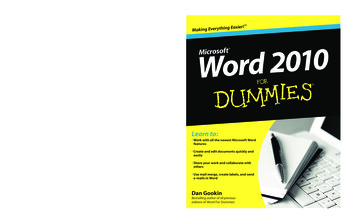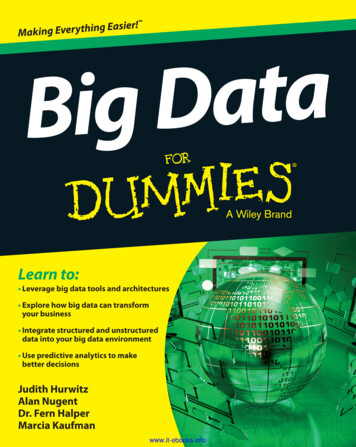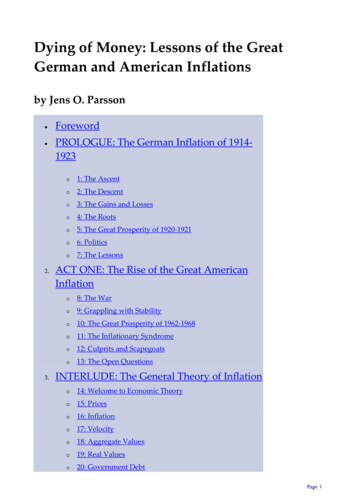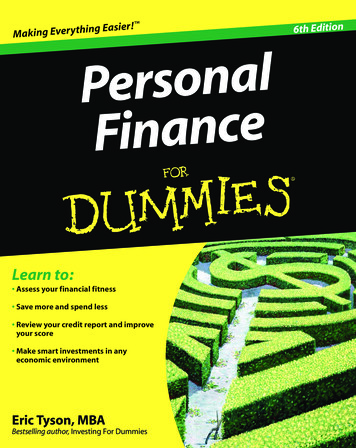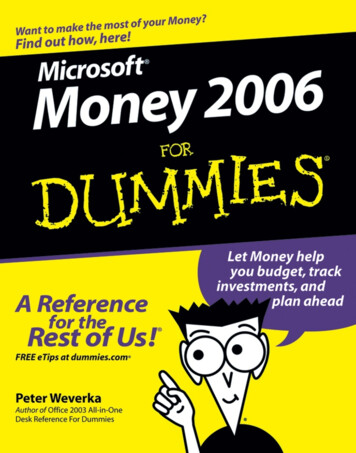
Transcription
MicrosoftMoney 2006FORDUMmIES‰by Peter Weverka
MicrosoftMoney 2006FORDUMmIES‰
MicrosoftMoney 2006FORDUMmIES‰by Peter Weverka
Microsoft Money 2006 For Dummies Published byWiley Publishing, Inc.111 River StreetHoboken, NJ 07030-5774www.wiley.comCopyright 2005 by Wiley Publishing, Inc., Indianapolis, IndianaPublished by Wiley Publishing, Inc., Indianapolis, IndianaPublished simultaneously in CanadaNo part of this publication may be reproduced, stored in a retrieval system or transmitted in any form orby any means, electronic, mechanical, photocopying, recording, scanning or otherwise, except as permitted under Sections 107 or 108 of the 1976 United States Copyright Act, without either the prior writtenpermission of the Publisher, or authorization through payment of the appropriate per-copy fee to theCopyright Clearance Center, 222 Rosewood Drive, Danvers, MA 01923, (978) 750-8400, fax (978) 646-8600.Requests to the Publisher for permission should be addressed to the Legal Department, Wiley Publishing,Inc., 10475 Crosspoint Blvd., Indianapolis, IN 46256, (317) 572-3447, fax (317) 572-4355, or online athttp://www.wiley.com/go/permissions.Trademarks: Wiley, the Wiley Publishing logo, For Dummies, the Dummies Man logo, A Reference for theRest of Us!, The Dummies Way, Dummies Daily, The Fun and Easy Way, Dummies.com, and related tradedress are trademarks or registered trademarks of John Wiley & Sons, Inc. and/or its affiliates in the UnitedStates and other countries, and may not be used without written permission. All other trademarks are theproperty of their respective owners. Wiley Publishing, Inc., is not associated with any product or vendormentioned in this book.LIMIT OF LIABILITY/DISCLAIMER OF WARRANTY: THE PUBLISHER AND THE AUTHOR MAKE NO REPRESENTATIONS OR WARRANTIES WITH RESPECT TO THE ACCURACY OR COMPLETENESS OF THE CONTENTS OF THIS WORK AND SPECIFICALLY DISCLAIM ALL WARRANTIES, INCLUDING WITHOUTLIMITATION WARRANTIES OF FITNESS FOR A PARTICULAR PURPOSE. NO WARRANTY MAY BE CREATED OR EXTENDED BY SALES OR PROMOTIONAL MATERIALS. THE ADVICE AND STRATEGIES CONTAINED HEREIN MAY NOT BE SUITABLE FOR EVERY SITUATION. THIS WORK IS SOLD WITH THEUNDERSTANDING THAT THE PUBLISHER IS NOT ENGAGED IN RENDERING LEGAL, ACCOUNTING, OROTHER PROFESSIONAL SERVICES. IF PROFESSIONAL ASSISTANCE IS REQUIRED, THE SERVICES OF ACOMPETENT PROFESSIONAL PERSON SHOULD BE SOUGHT. NEITHER THE PUBLISHER NOR THEAUTHOR SHALL BE LIABLE FOR DAMAGES ARISING HEREFROM. THE FACT THAT AN ORGANIZATIONOR WEBSITE IS REFERRED TO IN THIS WORK AS A CITATION AND/OR A POTENTIAL SOURCE OF FURTHER INFORMATION DOES NOT MEAN THAT THE AUTHOR OR THE PUBLISHER ENDORSES THE INFORMATION THE ORGANIZATION OR WEBSITE MAY PROVIDE OR RECOMMENDATIONS IT MAY MAKE.FURTHER, READERS SHOULD BE AWARE THAT INTERNET WEBSITES LISTED IN THIS WORK MAY HAVECHANGED OR DISAPPEARED BETWEEN WHEN THIS WORK WAS WRITTEN AND WHEN IT IS READ.For general information on our other products and services, please contact our Customer CareDepartment within the U.S. at 800-762-2974, outside the U.S. at 317-572-3993, or fax 317-572-4002.For technical support, please visit www.wiley.com/techsupport.Wiley also publishes its books in a variety of electronic formats. Some content that appears in print maynot be available in electronic books.Library of Congress Control Number is available from the publisher.ISBN-13: 978-0-7645-9953-8ISBN-10: 0-7645-9953-4Manufactured in the United States of America1098761O/RV/QY/QV/IN54321
About the AuthorPeter Weverka is the bestselling author of several For Dummiesbooks, including Office 2003 All-in-One Desk Reference For Dummies,The Everyday Internet All-in-One Desk Reference For Dummies, and29 other computer books about various topics. Peter’s books havebeen translated into 16 languages and sold three-quarter of a million copies. His humorous articles and stories — none related tocomputers, thankfully — have appeared in Harper’s, SPY, and othermagazines for grown-ups.
DedicationFor my pals in the South End Rowing Club.Author’s AcknowledgmentsThis book owes a lot to many hard-working people at the offices ofJohn Wiley & Sons in Indiana. I am very grateful to Bob Woerner forgiving me the opportunity to write it, and Susan Christophersen forbeing such a devoted project editor and copy editor.Thanks go to technical editor Allen Wyatt for dogging my everystep to make sure this book is indeed accurate. I would also like tothank TECHBOOKS Production Services for writing the index andRich Tennant for the witty cartoons you will find on the pages ofthis book.The first edition of this book came out in 1998! I would be remiss ifI didn’t thank the talented editors who worked on earlier editionsof this book, so thank you Steve Hayes, Beth Taylor, Jim McCarter,Kyle Looper, Tammy Castleman, Kathleen Dobie, Stephanie Koutek,Brian Kramer, Patricia Pan, Rev Mengle, Diane Smith, and GarethHancock.Finally, thanks go to my family — Sofia, Henry, and Addie — forindulging my vampire-like work schedule and my eerie demeanorat daybreak.Peter WeverkaSan FranciscoJune 2005
Publisher’s AcknowledgmentsWe’re proud of this book; please send us your comments through our online registration formlocated at www.dummies.com/register/.Some of the people who helped bring this book to market include the following:Acquisitions, Editorial, andMedia DevelopmentComposition ServicesProject Coordinator: Shannon SchillerProject and Copy Editor:Susan ChristophersenLayout and Graphics: Carl Byers, Andrea Dahl,Stephanie D. Jumper, Lynsey OsbornAcquisitions Editor: Bob WoernerProofreaders: Leeann Harney, Joe NiesenTechnical Editor: Allen WyattIndexer: TECHBOOKS Production ServicesEditorial Manager: Carol SheehanEditorial Assistant: Amanda FoxworthCartoons: Rich Tennant (www.the5thwave.com)Publishing and Editorial for Technology DummiesRichard Swadley, Vice President and Executive Group PublisherAndy Cummings, Vice President and PublisherMary Bednarek, Executive Acquisitions DirectorMary C. Corder, Editorial DirectorPublishing for Consumer DummiesDiane Graves Steele, Vice President and PublisherJoyce Pepple, Acquisitions DirectorComposition ServicesGerry Fahey, Vice President of Production ServicesDebbie Stailey, Director of Composition Services
Contents at a GlanceIntroduction .1Part I: Setting Up and Starting Out .5Chapter 1: Introducing Money .7Chapter 2: The Basics .17Chapter 3: Setting Up Your Accounts .27Chapter 4: Recording Your Financial Activity .39Part II: Banking with Money .67Chapter 5: Categorizing Your Spending and Income .69Chapter 6: Reconciling, or Balancing, an Account .89Chapter 7 Writing and Printing Checks .101Part III: Money for Investors .117Chapter 8: Setting Up Investment Accounts .119Chapter 9: Tracking the Value of Your Investments .133Chapter 10: Researching and Analyzing Your Investments .157Part IV: Getting Your Money’s Worth .171Chapter 11: Some Important Housekeeping Chores .173Chapter 12: Pinching Your Pennies .191Chapter 13: Planning for the Years Ahead .215Chapter 14: Preparing for Tax Time .231Part V: Improving Your Financial Picture .245Chapter 15: Reports and Charts for Seeing Where You Stand Financially .247Chapter 16: Tracking Assets, Liabilities, Loans, and Mortgages .267Part VI: Going Online with Money .285Chapter 17: Getting Ready to Go Online .287Chapter 18: Banking and Bill Paying Online .299Part VII: The Part of Tens .309Chapter 19: Ten Things You Should Do Periodically .311Chapter 20: Ten Ways to Good Health — Financially Speaking, That Is .315
Chapter 21: Ten Things to Do If You Are Self-Employed .319Chapter 22: Ten Things Ex-Quicken Users Should Know about Money .323Appendix: Glossary of Financial Terms .329Index .333
Table of ContentsIntroduction .1About This Book .1Foolish Assumptions .2Conventions Used in This Book .2Icons Used in This Book .3Part I: Setting Up and Starting Out .5Chapter 1: Introducing Money . . . . . . . . . . . . . . . . . . . . . . . . . . . . . . . . . . .7Starting Money .8Creating a shortcut icon for Money .8Pinning Money to the Start menu .8Starting Money for the First Time .9Discovering How Money Can Help You with Your Finances .11Keeping accurate records of your spending and income .11Categorizing your spending and income .12Estimating your income taxes .13Handling your investments .13Pinching your pennies .14Planning ahead .14Banking online .14Shutting Down Money .15Chapter 2: The Basics . . . . . . . . . . . . . . . . . . . . . . . . . . . . . . . . . . . . . . . . .17Getting Around in Money .17Links for going from window to window .17Toolbar buttons for getting around .18Tabs for going to different windows .19Customizing the Home Page Window .21Browsing the Web in Money .22Customizing the Toolbar .24Chapter 3: Setting Up Your Accounts . . . . . . . . . . . . . . . . . . . . . . . . . . . .27Accounts and Registers for Recording Financial Transactions .27The Basics: Setting Up Checking and Savings Accounts .30Setting up a checking or savings account .30Listing contact names, phone numbers, and other information .32
xiiMicrosoft Money 2006 For DummiesChanging an Account’s Name or Type .34Setting Up an Account to Track Credit Card and Line of CreditTransactions .35Chapter 4: Recording Your Financial Activity . . . . . . . . . . . . . . . . . . . . .39Opening an Account Register .39Recording Transactions in Registers .42Types of transactions .42Entering a transaction .44Splitting a Transaction .47Recording a Deposit or Debit Card Purchase with Cash Back .49Transferring Money between Accounts .51Recording Transactions in Credit Card and Line of Credit Accounts .52Recording credit card and line of credit charges .52Recording a credit .54Recording a credit card payment .54Fixing Mistakes in Account Registers .55Finding a transaction so that you can fix it .56Changing or editing transactions .60Voiding and Deleting Transactions .61Moving a Transaction from One Account to Another .63Printing a Register .64Part II: Banking with Money .67Chapter 5: Categorizing Your Spending and Income . . . . . . . . . . . . . . .69Looking at the Ways to Categorize Income and Spending .70By category .70By subcategory .70By classification .71By tax-related status .71Setting Up Your Own Categories and Subcategories .71Creating a new category in the New Category dialog box .72Creating a new subcategory .74Editing and Refining a Category or Subcategory .75Setting Up and Defining a Classification .77Setting up a classification .78Defining classes and subclasses .79Correcting Transactions that Were Recorded in the Wrong Category .80Moving all transactions from one category to another category .81Reassigning transactions to new categories .82Renaming and Deleting Categories and Classifications .84Renaming a category or subcategory .84Renaming a classification .85Deleting a category or subcategory .85Deleting a classification .87
Table of ContentsChapter 6: Reconciling, or Balancing, an Account . . . . . . . . . . . . . . . .89How Reconciling Works .89Balancing an Account .90Telling Money which transactions cleared the bank .91Fixing mistakes as you reconcile .94Help! The Darn Thing Won’t Reconcile! .94A checklist of things to do if you can’t reconcile .95“AutoReconciling” an account .97Forcing an account to balance .97Reconciling a Credit Card Account .98Chapter 7: Writing and Printing Checks . . . . . . . . . . . . . . . . . . . . . . . .101Deciding What Kind of Check to Order .102Ordering the Checks .103Getting Your Printer Ready to Print Checks .105Recording Checks that You Intend to Print .106Testing to See Whether Checks Print Correctly .108Printing a practice check .108Making adjustments to the text alignment .109Printing Your Checks .111Printing a full sheet of checks .111Printing partial sheets of checks .112Whoops! My Checks Didn’t Print Correctly .114Part III: Money for Investors .117Chapter 8: Setting Up Investment Accounts . . . . . . . . . . . . . . . . . . . . .119Your Own Electronic Portfolio Manager .119Setting Up an Investment Account for Tracking Securities .121Setting Up a Retirement Account for Tracking Retirement Savingsand Investments .124Setting Up an Account to Track Employee Stock Options .128Tracking Securities You Don’t Own in a Watch Account .130Chapter 9: Tracking the Value of Your Investments . . . . . . . . . . . . . . .133Recording Payments to (and Disbursements from) Brokers .134Describing the Securities in Investment and Retirement Accounts .135Handling Stocks .138Recording a purchase of stocks .138Recording the sale of stocks .139Recording and reinvesting dividends from stocks .142Recording stock splits, short sells, margin purchases, andother esoterica .142xiii
xivMicrosoft Money 2006 For DummiesHandling Mutual Funds .144Recording the sale or purchase of mutual funds .145Recording dividends and distributions .145Handling Bonds .147Recording the purchase of a bond .148Recording interest payments from bonds .150Other Kinds of Investments .150Precious metals .151Certificates of deposit .151Editing and Deleting Investment and Retirement AccountTransactions .151Updating the Price of Securities .152Downloading stock and mutual fund quotes from theInternet .153Updating the price of securities on your own .155Chapter 10: Researching and Analyzing Your Investments . . . . . . . .157Analyzing Your Investments .157Charting the Performance of an Investment .160Reviewing Your Portfolio .161Seeing How Well Your Investments Are Allocated .162Generating Investment Reports .163Being Alerted When a Security Hits a Certain Price .164Researching Investments at MoneyCentral .165Other Ways to Research Investments Online .166Researching mutual funds on the Internet .166Researching stocks on the Internet .167Researching bonds on the Internet .168Finding a Broker .169Part IV: Getting Your Money’s Worth .171Chapter 11: Some Important Housekeeping Chores . . . . . . . . . . . . . .173Backing Up and Restoring Money Files .173Telling Money how to back up your financial data .174Backing up your data file .176Restoring a file from its backup copy .177Transferring Your Money File to a New Computer .179Pruning the Payees List .179Organizing Your Favorite Accounts, Reports, and Web Sites .180Protecting Files with a Password or Passport Network Credentials .181Locking a file with a password or Microsoft passport .181Opening a file that has been given a password .183Changing and removing passwords .184
Table of ContentsDeleting and Closing Bank Accounts .184Closing an account .185Deleting an account .186Creating an Archive File for Past Transactions .186Creating a Separate File for Financial Activity .187Creating the separate file .187Opening the Money file you want to work with .188Renaming and Deleting Money Files .189Chapter 12: Pinching Your Pennies . . . . . . . . . . . . . . . . . . . . . . . . . . . .191Scheduling Bills So That They Are Paid on Time .191Scheduling a bill payment or deposit .193How Money tells you to pay bills .196Scheduling deposits, transfers, and investment purchases .197Recording a scheduled transaction in a register .197Skipping a scheduled transaction .198Changing a scheduled transaction .199Canceling a scheduled transaction .199Budgeting with Money .200Choosing between advanced and essential budgets .201Getting started with an advanced budget .202Enter your income: Telling Money about your income .204Enter your expenses: Budgeting your monthly expenses .207Savings goals: Declaring what to do with extra money .208Budget summary and status .208Formulating an essential budget .209Seeing whether you met your budget goals .210Working with more than one budget . . . .211Tracking Your Frequent Flyer Miles .212Chapter 13: Planning for the Years Ahead . . . . . . . . . . . . . . . . . . . . . . .215Being Alerted to Important Events .215Projecting Your Cash Flow .217Introducing the Lifetime Planner .219About you: Telling Money about yourself and your dependents .221Income: Describing your present and future income .221Taxes & Inflation: Describing the tax and inflation rate .222Savings & Investments: Describing your retirement savings .223Expected Return: Describing how your money will grow .224Homes & Assets: Describing things of value that you own orwill own .224Loans & Debt: Describing current and future loans .224Expenses: Describing the cost of living .225Results: Reading your financial future .226Action Plan: What you should do next .226Playing “what if” with your future .227Planning to Get Out of Debt .228xv
xviMicrosoft Money 2006 For DummiesChapter 14: Preparing for Tax Time . . . . . . . . . . . . . . . . . . . . . . . . . . . .231Tagging Categories for Tax-Reporting Purposes .231Looking at Line-Item Income and Expenses .234Generating Tax Reports .235Estimating Your Tax Bill .235Scheduling Important Tax Dates .238Getting Help for Lowering Your Tax Bill .238Determining How Much to Withhold .239Estimating Capital Gains Taxes .240Exporting Money Data to a Tax-Preparation Program .242Getting Tax Help on the Internet .244Part V: Improving Your Financial Picture .245Chapter 15: Reports and Charts for SeeingWhere You Stand Financially . . . . . . . . . . . . . . . . . . . . . . . . . . . . . . . . .247A Look at the Reports Home Window .248Looking at the Different Reports .250Income and Expenses .250Investment .251Assets and Liabilities .252Taxes .255Comparison Reports: For comparing the past with the present .255Monthly Reports .256My Favorites .256Creating a Report or Chart .256Generating the report or chart .256Turning reports into charts and charts into reports .257Investigating the figures from which a chart or report isconstructed .258Customizing Reports and Charts .
Peter Weverka is the bestselling author of several For Dummies books, including Office 2003 All-in-One Desk Reference For Dummies, The Everyday Internet All-in-One Desk Reference For Dummies, and 29 other computer books about various topics. Peter’s books have been translated into



